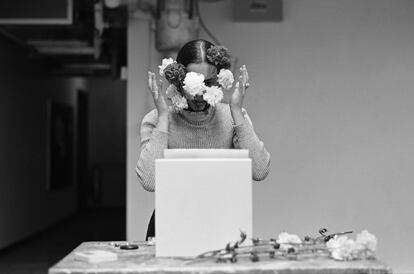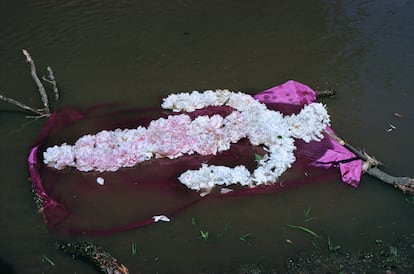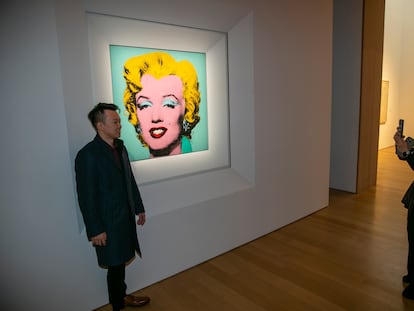Ana Mendieta, the artist who foreshadowed the 21st century
A new exhibition explores the ecofeminism, search for identity and ancestral wisdom in the Cuban-American’s work


When curating the Search for Origin exhibition, a comprehensive exploration of the career of the Cuban-American artist Ana Mendieta (1948-1985), the team led by Vincent Honoré and Rahmouna Boutayeb established two guiding principles for the exhibition.
As Honoré explains while walking through the mostly empty halls of the MO.CO. contemporary art center in Montpellier (southern France), the first principle was to evaluate and identify the contemporary relevance of the artist. As far back as the 1970s, Mendieta brought themes to the forefront that are still topical today — ecofeminism, violence against women, nature veneration, the value of ancestral wisdom, using the body to understand the world, and the search for identity.

Given the current relevance of these themes, the second principle was to emphasize their modernity and avoid projecting a 21st-century vision onto the artist’s work. For the exhibition, the curators aimed to avoid mimicking her voice. Instead, they focused on exploring the impact of her ideas on her art, writing, research, and the community she established with artists such as Nancy Spero and Mary Beth Edelson. “She would always come back to certain motifs, techniques and structures. And that’s what we aim to showcase,” said Honoré, the museum’s exhibition director, which is also hosting one dedicated to German painter Neo Rauch. “We wanted to show how complex her work is because she’s often tied to certain clichés. The idea was to break free from those clichés.”
When discussing the stereotypes surrounding Ana Mendieta, Honoré warns against an oversimplified view of her legacy. This view portrays her solely as a conceptual artist or primarily as a feminist activist. “She was always questioning the whole concept of belonging to a country, a political system, feminism, or even certain aesthetic structures. She just kept reinventing herself all the time,” said Honoré, who later pointed out how quickly Mendieta integrated the artistic movements and expressive mediums of her time, from performance to video and photography.

The big black cloud, the ultimate cliché, only surfaces towards the end of the conversation. The curators would rather focus solely on the artist’s work, on what they had the power to decide and act upon. However, Mendieta is often remembered as a feminist icon, not so much for her art, but for her untimely and unexplained death. She fell from the balcony of the house she shared in New York with her husband, minimalist sculptor Carl Andre. They were heard arguing violently on the night of September 8, 1985. The incident, for which Andre was tried and found not guilty, was overshadowed by a feeling of injustice. In 1992, a protest was held in front of the Guggenheim Museum in New York, which was showcasing Andre’s work at the time. The protest evolved into a movement with one enduring question: “Where is Ana Mendieta?”
This exhibition aims to provide a clear answer to the question. It will be at MO.CO. until September 17 and then move to MUSAC, the contemporary art museum in León (Spain) until early 2024. Ana Mendieta’s work truly shines in the exhibition rooms, highlighting her versatile and visionary artistic vision. Although her life ended tragically, she overcame her early circumstances as a Cuban immigrant who arrived in the U.S. at the age of 12 with her older sister, Raquel, as part of Operation Peter Pan (the clandestine exodus of over 14,000 unaccompanied Cuban minors to the United States from 1960 to 1962).
Hailing from an art-focused family, Mendieta arrived in Miami and eventually settled in Iowa. There, she delved into the study of primitive art while creating her own paintings. The exhibition features four of her previously unseen paintings, along with several photographs that surfaced during the curators’ research. Honoré said the reason these paintings (including a powerful self-portrait that accentuates her Black ancestry) were never exhibited is that Mendieta believed “painting was an inadequate medium for expressing the strength and energy she wanted to convey.”

The exhibition consistently showcases Mendieta’s dual nature in her art through photographs, videos and recreated scenes in the museum. Mendieta’s early works depict her body as the protagonist, a body that decried violence while integrating the natural world. Over time, she introduces the symbolic silhouette of a feminine form, representing the fusion of the body art and land art she pioneered. Her performance art symbolized the communion between the individual and nature, although she never used these limiting labels for her work.
Mendieta creates ephemeral female silhouettes among trees, rocks, rivers, beaches, caves and ancient tombs. By using perishable materials like fire, blood, sand and tree branches, she merges ancestral tradition and a contemporary perspective. Her works blur the line between the visible and invisible, the permanent and transient. “She was always playing around with these concepts, putting herself right in the middle to harness all that vital energy,” said Honoré.
The exhibition focuses on the silhouette as a representation of the connection between body and nature. It celebrates contemporary political and vibrant work, according to the press release. Not aiming to be an exhaustive retrospective, the exhibition excludes certain works like Facial Hair Transplants (1972), where Mendieta challenged beauty standards and feminine stereotypes by gluing hair to her face. These works have become ingrained in the collective imagination, but the exhibition explores other ways Mendieta paved the way for modernity through her use of the body as a cultural battlefield.
During the early 1980s, while living in New York, her work started to exhibit a preference for verticality. Instead of remaining on the ground, her figures began to rise towards the sky. In Rome, where she spent one year on a scholarship, she dedicated herself to creating drawings that emphasized the balance between perspectives that she had pursued throughout her artistic journey. “She is an amazing artist, and we just have to keep going back to it again and again,” said Honoré. “There’s a lot to say about it, but her work always manages to defy any kind of tidy summary.”
Sign up for our weekly newsletter to get more English-language news coverage from EL PAÍS USA Edition
Tu suscripción se está usando en otro dispositivo
¿Quieres añadir otro usuario a tu suscripción?
Si continúas leyendo en este dispositivo, no se podrá leer en el otro.
FlechaTu suscripción se está usando en otro dispositivo y solo puedes acceder a EL PAÍS desde un dispositivo a la vez.
Si quieres compartir tu cuenta, cambia tu suscripción a la modalidad Premium, así podrás añadir otro usuario. Cada uno accederá con su propia cuenta de email, lo que os permitirá personalizar vuestra experiencia en EL PAÍS.
¿Tienes una suscripción de empresa? Accede aquí para contratar más cuentas.
En el caso de no saber quién está usando tu cuenta, te recomendamos cambiar tu contraseña aquí.
Si decides continuar compartiendo tu cuenta, este mensaje se mostrará en tu dispositivo y en el de la otra persona que está usando tu cuenta de forma indefinida, afectando a tu experiencia de lectura. Puedes consultar aquí los términos y condiciones de la suscripción digital.
More information
Archived In
Últimas noticias
Most viewed
- Alain Aspect, Nobel laureate in physics: ‘Einstein was so smart that he would have had to recognize quantum entanglement’
- Mexico’s missing people crisis casts a shadow over World Cup venue
- Why oil has been at the center of Venezuela-US conflicts for decades
- Trump clarifies who is ultimately in charge in Venezuela: ‘Me’
- Mexico seeks to shore up its defenses following US incursion in Venezuela










































